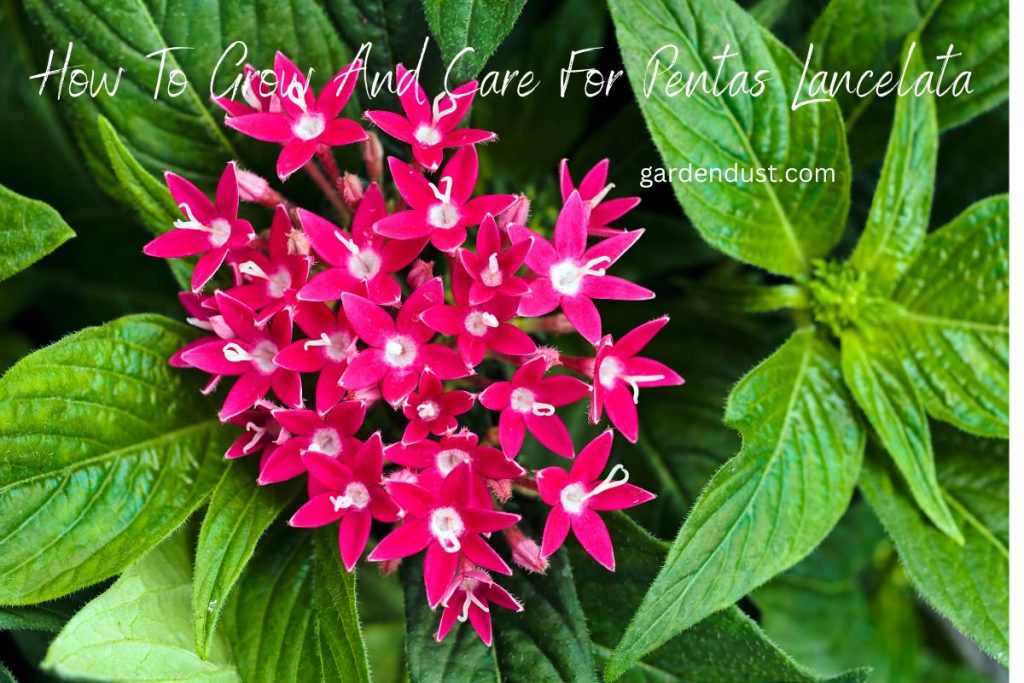Pentas lanceolata, commonly known as Pentas, is a popular flowering plant. In this article we will discuss about how to grow and care for Pentas lancelata..
Botanical Name-Pentas lanceolata
Family– Rubiaceae
Native-Africa
Uses – ornamental plant
Common Name -Egyptian Star Cluster
Plant
Pentas plants typically grow up to 2-3 feet tall and have a spread of 1-2 feet. They have dark green, lance-shaped leaves that are arranged opposite each other along the stem. The flowers are produced in clusters at the ends of the stems and come in a range of colors, including pink, red, lavender, and white. The flowers are tubular in shape and have five petals, hence the name “Pentas.”
Pentas plants are known for their long blooming period, which typically lasts from spring through fall. Plant prefer full sun to partial shade and well-drained soil that is kept moist but not waterlogged. They are relatively easy to care for and are attractive to butterflies and hummingbirds, making them a popular choice for butterfly gardens and pollinator-friendly landscapes.
Flower
Pentas produces small, star-shaped flowers that are arranged in clusters at the end of long stems. The flowers come in a range of vibrant colors, including shades of pink, red, lavender, and white.
The flowers are tubular in shape, with five petals that are fused at the base. The petals flare outwards from the base, creating a star shape. The flowers are typically around 1 inch in diameter and are produced in profusion throughout the growing season.
The flowers of Pentas are particularly attractive to butterflies and hummingbirds, making them a popular choice for pollinator-friendly gardens. They are also long-lasting and can be used as cut flowers in floral arrangements.
Grow And Care
Here are some care tips for Pentas lanceolata:
Soil:
Pentas plants prefer well-draining soil that is rich in organic matter. A slightly acidic to neutral soil with a pH range of 6.0 to 7.5 is ideal.
Watering:
Keep the soil moist but not waterlogged. Water the plants deeply once a week, or more often during hot, dry weather. Avoid overhead watering, as wet foliage can lead to disease problems.
Sunlight:
Pentas plants thrive in full sun to partial shade. They need at least 6 hours of direct sunlight per day to produce abundant flowers.
Fertilizer:
Use a balanced, slow-release fertilizer every 6 to 8 weeks during the growing season. Alternatively, you can apply a liquid fertilizer every 2 to 3 weeks.
Pruning:
Prune the plants regularly to promote bushy growth and remove spent flowers to encourage more blooms. Cut back the plants by about one-third in late winter or early spring to promote fresh growth.
Pests and Diseases:
Pentas plants are generally free of serious pest and disease problems. However, they can be susceptible to spider mites, whiteflies, and aphids. Watch for signs of infestation and treat promptly with insecticidal soap or neem oil if necessary.
Overall, Pentas is a relatively easy-to-grow plant that can provide months of colorful blooms with minimal care.
Common Disease And Pests
Pentas lanceolata is generally a hardy plant that is not prone to serious pest or disease problems. However, here are some common issues that can affect Pentas:
- Spider Mites: These tiny pests can cause yellowing, stippling, and webbing on the leaves of Pentas plants. They can be controlled with insecticidal soap or neem oil.
- Whiteflies: Whiteflies are small, white, flying insects that feed on the sap of Pentas plants. They can cause yellowing and stunted growth. They can be controlled with insecticidal soap or neem oil.
- Aphids: Aphids are small, soft-bodied insects that can cluster on the leaves and stems of Pentas plants. They can cause stunted growth and distorted leaves. They can be controlled with insecticidal soap or neem oil.
- Powdery Mildew: Powdery mildew is a fungal disease that can affect Pentas plants, causing a white, powdery coating on the leaves. It can be controlled by removing infected plant parts and treating the plant with a fungicide.
- Root Rot: Root rot is a fungal disease that can affect Pentas plants if they are overwatered or planted in poorly-draining soil. It can cause the plant to wilt and die. To prevent root rot, ensure that the soil is well-draining and that the plant is not overwatered.
Regularly monitoring the plant for signs of pests or disease and addressing any issues promptly can help to keep Pentas plants healthy and thriving.
Propagation
Pentas lanceolata can be propagated by several methods:
- Seeds: Pentas plants produce small, round seeds that can be collected and sown in late winter or early spring. Sow the seeds in well-draining soil and keep them moist until they germinate, which typically takes 10-14 days.
- Stem Cuttings: Take stem cuttings in late spring or early summer when the plant is actively growing. Cut 4-6 inch stems with a sharp, clean knife and remove the leaves from the bottom half of the stem. Dip the cut end in rooting hormone and plant the cutting in a pot filled with well-draining soil. Keep the soil moist and place the pot in a warm, bright location. The cuttings should root in 2-3 weeks.
- Division: Pentas plants can be divided in the spring or fall when they have become too large for their container or space. Dig up the plant and divide it into smaller sections, each with its own roots and shoots. Plant the divisions in well-draining soil and keep them moist until they are established.
With proper care and attention, Pentas lanceolata can be easily propagated by any of these methods. Happy Gardening…






